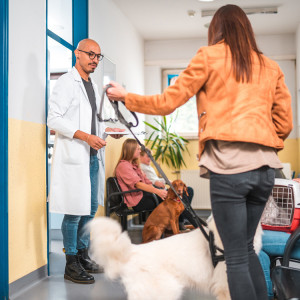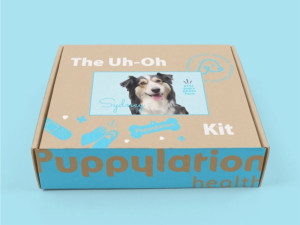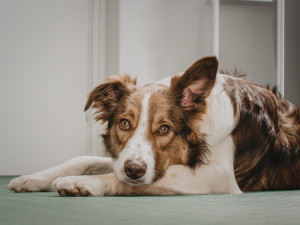Exploring the Safety of Neosporin For Dogs: Benefits, Risks, and Best Practices
You don’t always know how your dog ends up with a scratch or cut, but it’s important to know how to take care of it.

share article
Active dogs often end up with small nicks and scratches, even if we are keeping the closest eye on them. This is just one of the many ways pups are a lot like three-year-olds: They just tend to run into things and get mysterious wounds. Unlike three-year-olds (sometimes), dogs can never share what kind of mischief they got into, but hopefully they were living their best lives while they were doing it. Although these minor scrapes may not particularly bother dogs, many pup parents want to know what they can do at home to help these wounds heal.
Neosporin for Dogs
What is Neosporin?
Neosporin is the trade name of a petrolatum-based triple antibiotic ointment made for humans. Petrolatum is also known as petroleum jelly, soft paraffin, or white petrolatum. The three antibiotics are bacitracin zinc, neomycin sulfate, and polymyxin B, which are effective against a broad spectrum of bacteria. Some products contain a local pain killer called pramoxine as well.
Can Neosporin be used on dogs’ wounds?
Use of Neosporin on dog wounds is not recommendedopens in a new tab. Dogs (and any other pets in the household) tend to lick any product applied to their skin or fur. Constant licking further contaminates the wound and allows the dog to ingest the medication. Applying Neosporin is generally unnecessary because small wounds tend to heal well on their own if kept clean, and larger or deeper wounds require veterinary attention.
How should I apply Neosporin to my dog?
If your veterinarian recommends using Neosporin or another triple antibiotic ointment on your dog’s wounds, it is applied in a thin layer to clean skin. It is never used in the eyes, ears, or by mouth. It is not intended for deep wounds or lacerations. If the wound is in an area your dog can lick (and they can turn into little acrobats when they really want to lick something), an e-collar will be needed to prevent them from licking. Before applying a new layer, the area should be gently cleaned to remove the previous layer of ointment.
What are the benefits of using Neosporin on dogs?
There are no proven benefits of using Neosporin on wounds in dogs. In humans, Neosporin is used as a first-aid product to help prevent infection of minor scrapes and burns. The formulation promotes wound healing faster than bandaging alone, and it may help minimize the appearance of scars.
When should you seek veterinary care for using Neosporin in dogs?
Can Neosporin be harmful if ingested by dogs?
If ingested by a dog, Neosporin can cause loss of appetiteopens in a new tab, vomitingopens in a new tab, and greasy diarrheaopens in a new tab. If your dog ingests a large amount of the ointment, contact your veterinarian or an animal poison control center for advice.
What should I do if my dog shows signs of an allergic reaction to Neosporin?
If your dog is showing signs of an allergic reaction to Neosporin, contact your veterinarian or an emergency vetopens in a new tab as soon as possible. If you have applied the ointment topically, clean the area well to remove the product. If your dog ingested the ointment, do not induce vomiting unless specifically advised to by your veterinarian. Petroleum products have an increased risk of getting into the lungs, causing pneumonia when vomited.
Are there any potential risks or side effects of using Neosporin on dogs?
Like any drug, Neosporin can cause an allergic reaction in dogs. This can result in localized or generalized redness, itchiness, swelling, or hives. Anaphylactic reactions to triple antibiotic ointments are rare, but can result in vomiting, diarrhea, pale gums, weakness, and collapse.
If ingested, Neosporin can cause GI upset, with symptoms including vomiting, loss of appetite, and diarrhea. One of the antibiotics, neomycin, belongs to a class of drugs that can cause ototoxicity, which can result in hearing loss. This is not expected with topical use, but is a risk associated with these types of drugs.
Are there any alternatives to Neosporin for treating wounds in dogs?
There are many different types of topical products for treating wounds in dogs. They are all best used under the guidance of your vet after they have assessed the wound and determined its severity, stage of healing, risk for infection, and need for sutures or bandaging. For contaminated wounds, some veterinarians will use Manuka honey, antibiotic-infused gauze, silver sulfadiazine, or other topical products beneath bandages to reduce contamination and speed healing of wounds.
Other at-home remedies, such as calendula ointment and tea tree oil have not been proven to be effective in dogs and may be harmful. Tea tree oil can cause serious problemsopens in a new tab in dogs, including loss of balance, muscle tremors, stiffness, and central nervous system (CNS) depression. Never apply or give something to your dog without consulting your vet’s office first.
While Neosporin is commonly used to help wound healing in people, it’s not very useful for dogs. There’s no evidence that it helps, and dogs are prone to lick it off anyway. If your dog has a small, superficial scrape, just clean it gently with soap and water and watch it to make sure it’s healing well. If your dog has a bigger or deeper wound, see your veterinarian to make sure you give it the best chance to close up without incident.
FAQs:
1) Can Neosporin be used on dogs’ wounds?
Using Neosporin on your dogs’ wounds is not recommended. Small wounds heal well on their own if kept clean, and bigger wounds need veterinary attention.
2) Are there any potential risks or side effects of using Neosporin on dogs?
Neosporin can cause local irritation and allergic reactions. Dogs also love to lick ointments off their wounds, which can introduce more bacteria into them.
3) Can Neosporin be harmful if ingested by dogs?
Neosporin can cause loss of appetite, vomiting, and greasy diarrhea if ingested. Keep Neosporin and all other medications out of the reach of your dog.
4) Which ointment is best for wound healing for dogs?
Your veterinarian may recommend different ointments to help your dog’s wound healing based on the wound’s age, size, and depth. Ointment is not needed for most wounds.
5) How should I apply Neosporin to my dog?
If your veterinarian recommends Neosporin for your dog’s wound, apply it per their instructions. Make sure your dog is not able to lick the ointment off.
6) What should I do if my dog shows signs of an allergic reaction to Neosporin?
If your dog has an allergic reaction to Neosporin, contact your vet or animal poison control center ASAP. Gently clean off any visible product. Do not induce vomiting.
Citations

Dr. Bartley Harrison, DVM
Dr. Bartley Harrison, DVM is a small animal veterinarian based in North Carolina who has practiced emergency medicine since graduating from the Texas A&M College of Veterinary Medicine. His primary interest areas include pain management, cardiology, and the treatment of shock.
He is a member of the Veterinary Emergency and Critical Care Society, American Veterinary Medical Association, and American Medical Writers Association. In addition to his clinical work, he writes pet health articles to help provide accurate information for both new and experienced pet parents. When he’s not working, he enjoys cooking, traveling, reading, and going on adventures with his dog.
Related articles
![A woman in a bright yellow-orange sweater holding a striped kitten in one hand and a credit card in the other while using her laptop in front of her]() opens in a new tab
opens in a new tabCan’t Pay Your Pet’s Vet Bills? These Orgs Can Help
When the bills rack up, these resources have your back.
![uh-oh kit for dogs]() opens in a new tab
opens in a new tabYou Need This Customizable, Vet-Designed First Aid Kit for Dogs
Just in case.
![A dog laying on the floor]() opens in a new tab
opens in a new tabWhat to Do If Your Dog Eats Gorilla Glue
The goo in that green-and-orange bottle can cause serious harm — get your dog to the vet ASAP.
![black and white dog looking ill laying on couch]() opens in a new tab
opens in a new tabWarning Signs Your Dog Needs to Go to the ER — Stat
Trust me, I’m a vet.
![Dog sitting on a couch in a living room with plants]() opens in a new tab
opens in a new tab5 Plants That Are Toxic to Your Dog
Thriving plants are spring’s whole thing—but these offenders can be perilous to pets.
![Woman holding a beagle in warm dappled summer light]() opens in a new tab
opens in a new tabYou’ve Got a Summer-Lovin’ Pup. Here’s How to Keep Them Safe
Some like it hot (but not most dogs). Here are the season’s health hazards, from fleas to foxtails.









